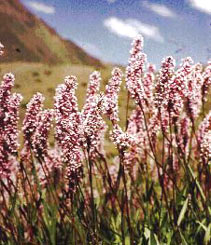HERBAL SOURCES OF TIBETAN MEDICINE

> HERBAL SOURCES OF TIBETAN MEDICINE <
Protecting the Himalayan varieties used in Tibetan medicines, exploring growing them as crops, and evaluating the healing properties of plants that grow elsewhere.
Tibetan medicine is celebrated as a source of sustainable and affordable healing preparations that are effective without lasting negative side effects. Our goal is to give people all over the world access to this unique insight into human well being.
Along with the need to provide training for a new generation of physicians and herbal pharmacists, and to translate the Tibetan medical so that students can begin their training without first having to learn to read Classical Tibetan, the main obstacle to wider use of Tibetan medicine is the limited supply of many herbs used in compounding the medications, some of which are already endangered by excessive non-professional harvesting.
His Holiness The Dalai Lama has warned that the health of the billions of people in the world cannot be sustained by medicines made with rare and endangered Himalayan plants. Even now, when Tibetan medicine has hardly begun to be practiced in Western countries, the herbs needed for making many of the medicines are in short supply. For example, the Men-Tse-Khang pharmacy in Dharamsala, India — the most respected source of Tibetan medicines — turns away all requests for medications except those accompanied by a prescription written by one of their own doctors. They will not accommodate even orders from their own graduates, those who have emigrated from India to other countries, explaining that to do so would deplete the supply of medicines needed in their branch clinics in India and Nepal.
Three different approaches to this scarcity of medicines are being explored. The most obvious and the most urgent is to preserve whenever possible the plants and animals currently used in Tibetan medicines, by protecting the ecologies that support those organisms, planting some species to increase the supply, and developing resources like seed banks to insure these species against extinction.
A second strategy is to extend the area where the herbs grow by planting in the wild and by finding ways of cultivating some species, as a way of preserving those that cannot be preserved in the wild, and as a way of increasing supplies.
The third is to evaluate the medicinal qualities of plants in other areas. Tibetan doctors have always used many imported materials in making their medicines, and believe that using substitute materials with similar therapeutic action is entirely appropriate when the ingredients of choice are unavailable. Tibetan physicians can identify plants indigenous to other areas that are suitable for use as substitutes for ingredients in traditional formulas and in developing new preparations.
Herbal medicine systems from other cultures will be useful in identifying promising species. Especially promising are two other systems which have ancient connections with Tibetan medicine and are still practiced: Indian Ayurvedic medicine and Chinese herbal medicine. Many of the herbs used in these systems are already used in Tibetan medicine.
The research needed for effort seems endless. The newsletter of the Chakpori Tibetan Medical Institute in Darjeeling, India, comments on some of the main issues: „To know which plants are vulnerable, endangered, or close to extinction, detailed studies have to be made. Also, the cause of rarity should be investigated (e.g., environmental causes, over exploitation by non-expert gathering, etc.). An important decision has to be made to replant not only the economically valuable plants but also the plants that are environmentally valuable and supportive of the total environment.
„Replanting sites should have the same characteristics as the original habitat. In traditional Tibetan medical texts, the side of the mountain, altitude, climatic condition, soil composition, etc. are mentioned [as important influences on the properties and potency of the herbs] …. research findings are essential guidelines for replanting the herbs in their natural environment. The size of the replanting area is also crucial because of genetic diversity and the problems of insular ecology. Monocultures, like the usual big plantations, should be avoided: mass plantations of certain species will not have the desired quality or power.“
Here on this page we offer links to Web sites relevant to preserving the plant species used in making Tibetan medicines, and increasing the supply of those herbs or finding substitutes, along with books and audio tapes on Tibetan herbs and related topics. Another page, Medical Research, Tibetan Style, gives resources relevant to other aspects of the immense task of preserving Tibetan medicine and making it available to the world.
> Meet Tibetan Incense Group at facebook <
> Meet Herbs for All Group at facebook <
> Meet the “ HERBS “ Group at facebook <
Comments are closed.